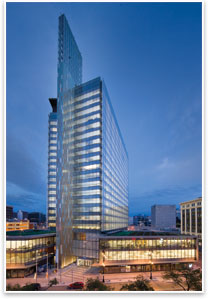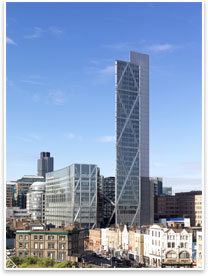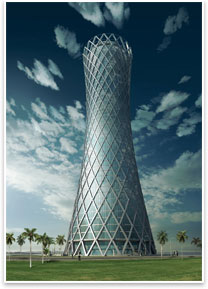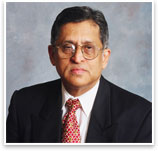A Shorter Crop of Winners in Council of Tall Buildings Annual Contest
Economic realities set in for skyscraper market
by Zach Mortice
Associate Editor
Summary: Last year, the Council on Tall Buildings and Urban Habitat (CTBUH) made the bewildering discovery that building heights were still rocketing upward, even in the midst of a global economic crisis. This year, the crisis remains, but rising heights of award-winning buildings do not. This year’s Best Tall Building awards are smaller, more modest, and comparatively humble. Only one pierces 50 stories.
Somehow, today’s design and construction economy is simultaneously topping out SOM’s 162-story Burj Dubai (a potential contender for next year’s awards that could completely bury the convenient recession-inspires-modesty narrative presented by this set of accolades) while also flirting with putting a Frank Gehry, FAIA, skyscraper under a budget and height restriction guillotine. These are strange times that speak to the uneven development, design, and construction cycle of the built environment, but for this year at least, the CTBUH is grounding their winning designs in market and sustainability realities.
These awards (as well as the Best Overall Tall Building, chosen from these entries) will be presented at an awards dinner to be held in conjunction with the CTBUH’s 2009 Conference: Evolution of the Skyscraper, on Oct. 22-23.
Best Tall Building in the Americas

Manitoba Hydro Place. Image courtesy of © Smith Carter.
Project: Manitoba Hydro Place
Architect: Kuwabara Payne McKenna Blumberg Architects
Location: Winnipeg, Manitoba
Height: 22 stories, 377 feet
Kuwabara Payne McKenna Blumberg Architects in Toronto designed Manitoba Hydro Place for a Canadian energy utility company in a city of extreme temperatures. This short, squat high rise emphasizes the verticality it does have with a vertical plane 22-story solar chimney that is slotted into its north façade. The chimney allows hot air to exhaust in the summer and keeps warm exhaust air in the building with a series of fan systems. From this north façade, the building splays open wider into three distinct glass-walled sections on the south façade, providing maximum solar exposure to the ideal south light and to strong southerly breezes. (The building is also always ventilated with fresh air, uses a geothermal heating and cooling system, and uses 60 percent less energy than a typical office building of its size.) This unique formal organization garnered the praise of the Council’s jury. They said Manitoba Hydro Place was “completely site specific—this design could not be transplanted to another city and still work, thus making it the perfect response to the seeming homogenization of the world’s skylines.”
Best Tall Building in Asia/Australasia

Steven Holl Architects Linked Hybrid. Image couresty of © Shu He.
Project: Linked Hybrid
Architect: Steven Holl Architects
Location: Beijing
Height: 21 stories, 223 feet
Nothing less than an attempt to reset Beijing’s scaleless and imposing development habits in a more humane direction, New York-based Steven Holl Architects’ Linked Hybrid consists of a circular series of residential and mixed-use towers connected by skywalks that hover over a central public plaza. The building gives public green space, retail and education spaces, and enlivening, unpredictable circulation routes back to the city to create a fine-grained (yet self-contained) urban experience that is very often lacking in super-block contemporary Chinese development patterns. Steven Holl, AIA, calls this a porous “micro-urbanism.” The project’s name refers to fusing two Chinese building models together: the low horizontality of Chinese buildings from antiquity to the late 20th century, and the surge of vertical monuments that took place after China’s capitalist awakening. The jury praised the project for its “rich palette” and “appropriate scale.”
Best Tall Building in Europe

SOM’s Broagate Tower. Image Courtesy of SOM | Richard Leeney © British Land.
Project: The Broadgate Tower
Architect: SOM
Location: London
Height: 35 stories, 585 feet
With its steel truss-laced facades, the Broadgate Tower in London harkens back to a previous SOM icon, the John Hancock Center in Chicago, this time in delicate white A-frames and glass instead of burly, black steel. The first speculative office tower built in the City of London, the skyscraper is placed on top of an important public transit hub and is supported over it by a 6,000-ton concrete and steel raft. The building begins at the ground with a covered public galleria containing shops, restaurants, bars, and other retail amenities. The building’s profile was designed to preserve view corridors to Christopher Wren’s St. Paul’s Cathedral. “An efficient solution structurally, the designers took advantage of the spaces created under the dramatic diagonal columns to create an energetic public space,” enthused the jury.
Best Tall Building in the Middle East/Africa

The Tornado Tower. Image courtesy of Grey Worldwide Doha.
Project: Tornado Tower
Architect: CICO Consulting Architects & Engineers/SIAT Architekten + Ingenieure
Location: Doha, Qatar
Height: 52 stories, 656 feet
A bold and iconic presence on Doha’s West Bay waterfront, this office building sports a hyperboloid vortex shape that tapers in the middle and expands at the top. Its exposed-steel structural system is covered in a lighting array that lights up the night sky with various colors and textures. (It can even make the tower appear to whirl and spin like a tornado.) The building’s office floor plates are column-free, and it sits on a three-level parking garage for 1,700 cars. “Tornado Tower employs an efficient and lightweight structure that allows for flexible floor plans and efficiencies in economics, construction, and energy,” said the jury.
Lynn S. Beedle Lifetime Achievement Award

John Portman, FAIA. Image courtesy of © Stephen Cord.
John Portman, FAIA
The Lynne S. Beedle Lifetime Achievement Award recognizes an individual who has made significant contributions to the advancement of tall buildings and the urban environment. For decades in the latter part of the 20th century, John Portman, FAIA, has designed buildings that, with their landscaped multi-story atriums and effusive sense of spectacle and event, virtually defined cosmopolitan urban life for Americans. Through the 1970s and ’80s, Portman’s buildings—such as the Westin Peachtree Plaza Hotel and Marquis Marriott in his Atlanta home base and San Francisco’s Embarcadero Center—became enlivening urban centers at a time when cities seemed to have lost their way. Portman was a very early proponent of mixed-use development and was afforded more opportunities to build this way than most because of his willingness to take on the role of developer as well as architect.
Fazlur Rahman Kahn Medal

Prabodh Banavalkar. Image courtesy of Ingenium, Inc.
Prabodh Banavalkar
The Fazlur Rahman Khan Medal for Lifetime Achievement recognizes an individual for demonstrated excellence in design and research that has made important contributions to the construction of tall buildings. Banavalkar and his Houston-based structural engineering firm Ingenium, Inc. are responsible for some of the nation’s most well-loved skyscrapers, the 73-story U.S. Bank Tower in Los Angeles by I.M. Pei, FAIA, chief among them. The tower has enough flexibility and redundancy to withstand an earthquake of up to 8.3 on the Richter scale, while still maintaining the necessary rigidity to resist changing wind conditions native to Southern California. Banavalkar has also frequently worked with last year’s Lynne S. Beedle Lifetime Achievement Award winner Cesar Pelli, FAIA. In 2005, they completed Philadelphia's Cira Center. Banavalkar is also a professor at Rice University. |








